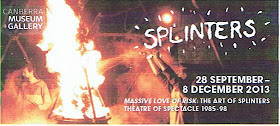A Canberra Critics' Circle Symposium on Splinters Theatre of Spectacle
Saturday November 2, from 1.30pm to 4pm at the Canberra Museum and Gallery Theatrette.
A brief reflection by Frank McKone
Chaired by CCC convenor, Helen Musa, each of the speakers took the floor for some 20 minutes, including questions from the small but keenly interested audience. Speakers were:
Patrick Troy, one of the founders of Splinters, who remained central to Splinters’ work throughout the company’s performances from 1985 to 1996, coming from a drama background in high school and secondary college, and Canberra Youth Theatre. He provided a lively sense of the variety, energy, and sometimes conflicting forces which stimulated the work of Splinters, as well as the often difficult times of touring with little finance. Discussion arose about the place of women, including leading performers and writers such as Pauline Cady, who subsequently became co-director of Snuff Puppets in Melbourne (http://www.snuffpuppets.com/) and the photographer Katherine Pepper, whose documenting of Splinters’ performances has formed an essential part of the exhibition at the Canberra Museum and Gallery Splinters Theatre of Spectacle: Massive love of risk (28 September – December 2013) (http://www.museumsandgalleries.act.gov.au/cmag/). The current director of ACT Museums and Galleries is Shane Breynard, also a supporter of Splinters in the 1980s.
Actor/Artist Renald Navilly who worked with Splinters over many years in a role which might best be described as enabler and shaper. He made it clear that his was never an authoritarian approach: his function was to hear ideas put forward by people, welcome all ideas however diverse, encourage people to be the authors of the development of ideas, and help guide the process of selection to create a dramatic structure in performance. He spoke of the influences on his philosophy and practice such as the Living Theatre (http://www.livingtheatre.org/about/history), Jerzy Grotowksi’s Polish Laboratory Theatre (http://en.wikipedia.org/wiki/Jerzy_Grotowski) and to some extent by the work of Antonin Artaud (http://en.wikipedia.org/wiki/Theatre_of_Cruelty).
Assistant Professor Dr Geoff Hinchcliffe, Media and Graphic Design at University of Canberra, was a participant in many Splinters performances, on stage and in visual design and effects, with a background in secondary college drama and tertiary training at the Canberra School of Art. He spoke on the visual culture developed by Splinters, but also took up discussion of the group collective approach which made Splinters into a social unit open to welcoming new participants and changing ideas, noting that possibly some 1000 people were involved over the decade.
Canberra author Joel Swadling spoke on the biography he is writing about the late David Branson, a founding member of Splinters as well as a key figure in a wide range of theatrical and musical work as director and performer until his tragic accidental death in 2001. As the work on the biography progresses, from a detailed study of nine boxes of Branson’s papers – now held in the ACT Heritage Library Manuscript Collection http://www.library.act.gov.au/find/history/search/Manuscript_Collections/David_Branson – and through extensive interviews with many of the people who knew and worked with Branson, a picture is forming of the quality and importance of his contribution to theatre arts in Canberra, Australia and internationally.
This writer, educator/theatre critic Frank McKone, spoke on the issue which others also alluded to: how did Splinters’ often anarchic approach to theatre arise in Canberra, the capital city largely populated by public servants, and seen by outsiders as a planned city with no soul. He proposed a theory that in 1968, the 19th year of conservative government, the accidental rise to the Prime Ministership of John Gorton, described as a man who liked to portray himself as a man of the people who enjoyed a beer and a gamble, with a bit of a "larrikin" streak about him, in stark contrast to the previous Liberal Party PMs, stirred the conventional public servants, by osmosis, to reject the control of Canberra’s education system by the authoritarian New South Wales Department, and to demand our own ACT Schools Authority. In starting a new system from scratch, including offering the first Drama courses in Australia at matriculation level, teachers found themselves with the freedom to “negotiate the curriculum” with their students from 1972, very much in the manner that Renald Navilly described in his work with Splinters participants from 1985.
The curator of the CMAG exhibition which included this Symposium, former Splinters member Gavin Findlay who joined after being impressed by the work they presented at the Performance Space, Redfern in Sydney, (http://www.performancespace.com.au/us/history/) then spoke on the archiving of Splinters records and how the materials and history form the basis of his doctoral research designed to recognise the place of Splinters in 20th Century theatre, nationally and internationally.
In discussion, as well as the developments in the schools in the 1970s, the importance of the establishment by Carol Woodrow (http://www.womenaustralia.info/biogs/AWE4882b.htm) of Canberra Children’s Theatre, Reid House Theatre Workshop, Canberra Youth Theatre, The Jigsaw Company, and The Fools’ Gallery during the same period, showed that Canberra was developing its own sense of authorship in both the educational and professional theatre circles, so that by the mid-1980s there was fertile ground for Splinters to grow among young people committed to the crossover of theatre and visual arts.
